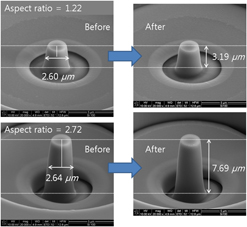Crossref Citations
This article has been cited by the following publications. This list is generated based on data provided by
Crossref.
Wheeler, J. M.
and
Michler, J.
2013.
Elevated temperature, nano-mechanical testing in situ in the scanning electron microscope.
Review of Scientific Instruments,
Vol. 84,
Issue. 4,
Zhang, J.Y.
Wang, Y.Q.
Wu, K.
Zhang, P.
Liu, G.
Zhang, G.J.
and
Sun, J.
2014.
Strain rate sensitivity of nanolayered Cu/X (X=Cr, Zr) micropillars: Effects of heterophase interface/twin boundary.
Materials Science and Engineering: A,
Vol. 612,
Issue. ,
p.
28.
Schoeppner, R.L.
Wheeler, J.M.
Zechner, J.
Michler, J.
Zbib, H.M.
and
Bahr, D.F.
2015.
Coherent Interfaces Increase Strain-Hardening Behavior in Tri-Component Nano-Scale Metallic Multilayer Thin Films.
Materials Research Letters,
Vol. 3,
Issue. 2,
p.
114.
Yilmaz, Ezgi D.
Jelitto, Hans
and
Schneider, Gerold A.
2015.
Uniaxial compressive behavior of micro-pillars of dental enamel characterized in multiple directions.
Acta Biomaterialia,
Vol. 16,
Issue. ,
p.
187.
Lee, Wen-Jay
Ho, Mon-Shu
Huang, Chih-Pong
Chou, Che-Fu
Tsai, Jyun-Hwei
and
Su, Wan-Sheng
2015.
Using a functional C84 monolayer to improve the mechanical properties and alter substrate deformation.
RSC Advances,
Vol. 5,
Issue. 59,
p.
47498.
Zhang, Zhen
Jun, Tea-Sung
Britton, T. Benjamin
and
Dunne, Fionn P.E.
2016.
Intrinsic anisotropy of strain rate sensitivity in single crystal alpha titanium.
Acta Materialia,
Vol. 118,
Issue. ,
p.
317.
Łusakowska, E.
Adamiak, S.
Adamski, P.
Kuna, R.
Minikayev, R.
Skupiński, P.
Szczerbakow, A.
and
Szuszkiewicz, W.
2017.
The Young Modulus and Microhardness Anisotropy in (Pb,Cd)Te Solid Solution Crystallizing in the Rock Salt Structure and Containing 5% of Cd.
Acta Physica Polonica A,
Vol. 132,
Issue. 2,
p.
343.
Seo, Eun Jung
Kim, Jin Kyung
Cho, Lawrence
Mola, Javad
Oh, Chang Yeol
and
De Cooman, Bruno C.
2017.
Micro-plasticity of medium Mn austenitic steel: Perfect dislocation plasticity and deformation twinning.
Acta Materialia,
Vol. 135,
Issue. ,
p.
112.
Waheed, S
Hao, R
Bhowmik, A
Balint, D S
and
Giuliani, F
2017.
A unifying scaling for the Bauschinger effect in highly confined thin films: a discrete dislocation plasticity study.
Modelling and Simulation in Materials Science and Engineering,
Vol. 25,
Issue. 5,
p.
054003.
Kang, Wonmo
Merrill, Marriner
and
Wheeler, Jeffrey M.
2017.
In situ thermomechanical testing methods for micro/nano-scale materials.
Nanoscale,
Vol. 9,
Issue. 8,
p.
2666.
Albiez, Almut
and
Schwaiger, Ruth
2019.
Size Effect on the Strength and Deformation Behavior of Glassy Carbon Nanopillars.
MRS Advances,
Vol. 4,
Issue. 2,
p.
133.
Chu, Kangjie
Yan, Kai
Ren, Fuzeng
and
Sun, Qingping
2019.
A dual-pillar method for measurement of stress-strain response of material at microscale.
Scripta Materialia,
Vol. 172,
Issue. ,
p.
138.
Shahrin, Rahnuma
and
Bobko, Christopher P.
2019.
Micropillar compression investigation of size effect on microscale strength and failure mechanism of Calcium-Silicate-Hydrates (C-S-H) in cement paste.
Cement and Concrete Research,
Vol. 125,
Issue. ,
p.
105863.
Best, James P.
Ast, Johannes
Li, Bosong
Stolpe, Moritz
Busch, Ralf
Yang, Fan
Li, Xiaopeng
Michler, Johann
and
Kruzic, Jamie J.
2020.
Relating fracture toughness to micro-pillar compression response for a laser powder bed additive manufactured bulk metallic glass.
Materials Science and Engineering: A,
Vol. 770,
Issue. ,
p.
138535.
Su, Ruizhe
Neffati, Dajla
Li, Qiang
Xue, Sichuang
Cho, Jaehun
Li, Jin
Ding, Jie
Zhang, Yifan
Fan, Cuncai
Wang, Haiyan
Kulkarni, Yashashree
and
Zhang, Xinghang
2020.
Ultra-high strength and plasticity mediated by partial dislocations and defect networks: Part I: Texture effect.
Acta Materialia,
Vol. 185,
Issue. ,
p.
181.
Su, Ruizhe
Neffati, Dajla
Li, Qiang
Xue, Sichuang
Fan, Cuncai
Cho, Jaehun
Zhang, Yifan
Li, Jin
Wang, Haiyan
Kulkarni, Yashashree
and
Zhang, Xinghang
2021.
Ultra-high strength and plasticity mediated by partial dislocations and defect networks: Part II: Layer thickness effect.
Acta Materialia,
Vol. 204,
Issue. ,
p.
116494.
Giuntini, Diletta
Davydok, Anton
Blankenburg, Malte
Domènech, Berta
Bor, Büsra
Li, Mingjing
Scheider, Ingo
Krywka, Christina
Müller, Martin
and
Schneider, Gerold A.
2021.
Deformation Behavior of Cross-Linked Supercrystalline Nanocomposites: An in Situ SAXS/WAXS Study during Uniaxial Compression.
Nano Letters,
Vol. 21,
Issue. 7,
p.
2891.
Li, Hongmei
Zhu, Tianqi
Takata, Naoki
Kobashi, Makoto
and
Yoshino, Masataka
2021.
Effect of trace solute titanium on plastic deformation of α-(Fe, Cr) single-crystal micropillars fabricated from 18Cr ferritic stainless steel.
Materials Science and Engineering: A,
Vol. 803,
Issue. ,
p.
140455.
Jaya, B. Nagamani
Mathews, Nidhin G.
Mishra, Ashwini K.
Basu, Soudip
and
Jacob, Kevin
2022.
Non-conventional Small-Scale Mechanical Testing of Materials.
Journal of the Indian Institute of Science,
Vol. 102,
Issue. 1,
p.
139.
Puttbach, C.
Prinz, G.S.
and
Murray, C.D.
2024.
Strength and stiffness characterization of ultra-high performance concrete (UHPC) cement paste phases through in-situ micro-mechanical testing.
Cement and Concrete Composites,
Vol. 149,
Issue. ,
p.
105520.
